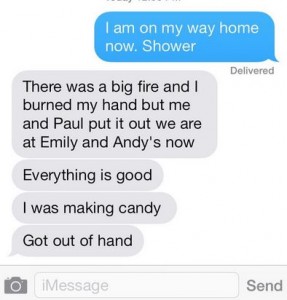Anxiety is the fastest growing disorder in children from elementary school to college. Anxiety interferes with learning, socializing, and inhibits social-emotional growth. Due to the systemic changes in education, the perennial threat from school violence (and its media coverage), our increased reliance on technology and the intensifying pressure students put on themselves to achieve, we are growing a problem that district leaders need to appreciate.
What is Anxiety?
Anxiety is different from worry, fear, and panic. The simplest way to differentiate between them is using the following vignettes: If a bear knocks on your door, that elicits fear. If you hear a radio broadcast of a located in your area, that is worry. If there is no indication a bear is present, yet are consumed with the idea, that is anxiety.
With anxiety, we become preoccupied with what may be, often to the point of creating disruption to our wellness, our relationships, or our work/school performance. Anxiety can be general, meaning it touches on multiple areas, or it can be concentrated into one area, such as a phobia. Anxiety can also be concentrated in panic attacks, which is essentially the fear of fear. Anxiety can also manifest in more enduring conditions such as obsessive- compulsive disorder.
There are two primary modes of anxiety, ruminative and anticipatory. Ruminative is when you spend time dwelling on the past and anticipatory is looking forward into what may be. Often times people have a combination of the two and in children the future oriented version is more prevalent.
What Causes Anxiety?
We are a society of overthinkers, which is the short answer. We analyze, judge, debate and a whole other set of processes using our brain. We tend to deemphasize our bodies in Western culture, ignoring our needs. Our body lets us know what needs are unmet or threatened, through signals we often label as symptoms. In doing so we use prescriptive measures to turn down the volume of the message in order to alleviate the symptom.
As we learn to increase our tolerance for discomfort, we can tune into what our body is trying to tell us, so that we can take action that gets our needs met, instead of alleviating the ‘symptom’. With children, it’s our job to help them tune into their bodies and understand their needs. If they aren’t able to communicate their needs, by expressing feelings, they will likely have a compounded effect which amplifies their frustration generating additional anxiety.
Anxiety is more common with perfectionists, people who are more rigid in their thinking, and those who isolate and/or avoid conflict. If we imagine anxiety as trapped energy, anything that internalizes feelings as opposed to acting upon them has the potential to create anxiety.
Some children develop existential anxiety early in their lives. This amounts to the fear of death, which less communicative or sensitive children may describe as a fear of the dark. At night, children may lie awake imagining their own or their parent’s death. Those children who haven’t yet mastered abstract thinking are more at risk, due to the harsh finality the concept of death presents.
Separation anxiety is a combination of insecurity and mistrust of the world. A child may latch onto a parent, sometimes out of their struggle to face the world alone or perhaps out of a deep- seated fear for the parent. Parents with anxiety often install cautionary tales with their children or model hesitancy, which can influence a child toward their own anxiety.
In families where trauma is present, chaos is frequent, or disruption to the family peace occurs, anxiety can result. Since the family serves as the anchor for attachment, any threat to that anchor stirs up fear that left untreated, can morph into anxiety.
Our increased reliance on technology has also had an impact on the prevalence of anxiety. As students emphasize more cognitive based activities that promote isolative problem solving, they lessen their contact with their bodies and their environments. As reliance and dependency on technology grows, children grow more intolerant of distress and have increased difficulty holding feelings in abeyance. Delayed gratification suffers and their trapped energy grows, a foundation for growing anxiety.
Not ADHD
There was a period of many years where the rates of attention deficit/ hyperactivity disorder surged in diagnosis. The number of children placed on medication grew as educators searched for ways to contain unruly students within a larger classroom. What’s better understood by educators and clinicians are the growing number of conditions that mirror ADHD, creating attentional problems.
Anxiety is high on that list, often times difficult to distinguish for pediatricians and other health care providers. Both conditions can show up as restlessness, distractibility, and poor concentration, making it easy to mistake. A risk is that ADHD medication of the stimulant variety, can exacerbate anxiety, so it’s important to have an evaluation by a psychologist before medication is attempted
How Does Anxiety Impact Learning?
For some children who are anxious, they may excel in school. In fact, some of your most diligent and conscientious students may be anxious, which would mean missing the underlying turmoil that drives their obsessive need to succeed.
For others, disruption to focus and memory can impede both processing and recall. Motivation may be diminished and agitation may adversely influence peer relationships. Younger students may seem like pests to the teacher but it’s also possible you won’t notice any overt signs to indicate anxiety is present. For some bright children who suffer with anxiety, they are private and withhold their struggle, to avoid embarrassment.
In short, anxiety can take on many different forms that you can’t look for any one thing. The most effective way to assess for anxiety is to have children write or talk about the things that worry them. Given the opportunity for catharsis, children will gravitate toward transparency. Remember that you may be put in a position where you now have information you aren’t sure what to do with or whether you can share. Having some early ground rules may help avert this problem.
What Can Teachers Can Do?
What hinders:
- Reassurance may be more effective in the short term but not in the long term
- Applying logic or reason to irrational thinking can sometimes help a child feel more frustrated
- Telling a child there is nothing to worry about can cause them to withhold sharing
- Not rushing to medication which interferes with recognition of sensations (needs)
- Over reliance on technology in the classroom
What helps:
- Understanding feelings and thoughts without judgment is comforting
- Telling a child, you are impressed or proud of their willingness to share something so personal
- Sharing your own struggles with worry or stress can help them feel less alone
- Creating a classroom and school environment where expressing differences is encouraged
- Bulling and intimidation is dealt with firmly but not through punitive measures
- Helping adjust for realistic expectations
- Celebrating inequities as human beings ought not be perfect
- Modelling directness with sensitivity
- Integrate social-emotional learning into curriculum (tolerance for distress)
- Use of mindfulness in the classroom
For more information on anxiety, please visit www.teachercoach.com and search the marketplace for our series on anxiety & children. Our software allows you to make this training available to both faculty and parents.



 ip deepens.
ip deepens.




